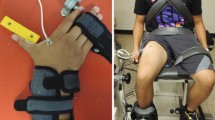Summary
Differing results have been reported concerning the direction and quantity of the electromyogram (EMG) amplitude response to changes in tissue temperature. The EMG signals from the soleus muscle of six healthy human subjects were therefore recorded during dynamic exercise (concentric contractions) at ambient temperatures of 30°C and 14°C. The mean skin temperature \((\bar T_{sk} )\)above the muscle investigated was 32.9° C and 21.7° C, respectively. The core temperature, estimated by rectal temperature, was unchanged. The cooling of the superficial tissues caused approximately a doubling of the EMG amplitude. For the probability level 0.9 in the amplitude probability distribution function, the average signal level increased from 73 μV to 135 μV (P=0.02). The average mean power frequency of the EMG signal was reduced from 142 Hz to 83 Hz (P=0.004). The amplitude increase was not due to shivering but other possible explanations are presented. As the changes in T sk investigated were within the range which may occur normally during the working hours, it was concluded that T sk should be carefully controlled in vocational EMG studies.
Similar content being viewed by others
References
Åstrand P-O, Rodahl K (1986) Textbook of work physiology. Physiological bases of exercise. McGraw-Hill, New York
Bigland-Ritchie B, Donovan EF, Roussos CS (1981) Conduction velocity and EMG power spectrum changes in fatigue of sustained maximal efforts. J Appl Physiol 51:1300–1305
Buchthal F, Pinelli P, Rosenfalck P (1954) Action potential parameters in normal human muscle and their physiological determinants. Acta Physiol Scand 32:219–229
De Luca CJ (1985) Myoelectrical manifestations of localized muscular fatigue in humans. CRC Crit Rev Biomed Eng 11:251–279
Fallentin N, Sidenius B, Jørgensen K (1985) Blood pressure, heart rate and EMG in low level static contractions. Acta Physiol Scand 125:265–275
Faulkner JA, Zerba E, Brooks SV (1990) Muscle temperature of mammals: cooling impairs most functional properties. Am J Physiol 259 (Regulatory Integrative Comp Physiol 28):R259-R265
Hagberg M (1981) On evaluation of local muscular load and fatigue by electromyography (Thesis). National Board of Occupational Safety and Health, Stockholm, Sweden, Arbete och Halsa 24:1–53
Jonsson B (1982) Measurement and evaluation of local muscular strain in the shoulder during constrained work. J Hum Ergot (Tokyo) 11:73–88
Jørgensen K, Fallentin N, Sidenius B (1989) The strain on the shoulder and neck muscles during letter sorting. Int J Ind Ergon 3:243–248
Lindström LR, Magnusson R, Petersén I (1970) Muscular fatigue and action potential conduction velocity changes studied with frequency analysis of EMG signals. Electromyography 4:341–353
Muza RS, Young AJ, Sawka MN, Pandolf KB, Bogart JE (1986) Power spectral analysis of the surface electromyogram during shivering. Aviat Space Environ Med 57:1150–1153
Noddeland H, Winkel J (1988) Effects of leg activity and ambient barometric pressure on foot swelling and lower-limb skin temperature during 8 h of sitting. Eur J Appl Physiol 57:409–414
Petrofsky JS (1979) Frequency and amplitude analysis of the EMG during exercise on the bicycle ergometer. Eur J Appl Physiol 41:1–15
Petrofsky JS, Lind AR (1980) The influence of temperature on the amplitude and frequency components of the EMG during brief and sustained isometric contractions. Eur J Appl Physiol 44:189–200
Rome LC, Loughna PT, Goldspink G (1984) Muscle fiber activity in carp as a function of swimming speed and muscle temperature. Am J Physiol 247 (Regulatory Integrative Comp Physiol 16):R272-R279
Sundelm G, Hagberg M, Hammarström U (1988) Work in draught-relation to muscle activity (in Swedish). Nordisk Arbeitsmiljömöte (book of abstracts, Hagberg M (ed)), pp 49–50. Available from The Swedish National Institute of Occupational Health
Westgaard RH (1988) Measurement and evaluation of postural load in occupational work situations. Eur J Appl Physiol 57:291–304
Winkel J (1985) On foot swelling during prolonged sedentary work and the significance of leg activity (Thesis). National Board of Occupational Safety and Health, Stockholm, Sweden, Arbete och Halsa 35:1–84
Winkel J, Jørgensen K (1986) Evaluation of foot swelling and lowerlimb temperatures in relation to leg activity during long-term seated office work. Ergonomics 29:313–328
Winkel J, Gard J (1988) An EMG-study of work methods and equipment in crane coupling as a basis for job redesign. Appl Ergon 19:178–184
Winkel J, Jørgensen K, Noddeland H (1988) Significance of ambient temperature for foot swelling and oedema-preventing effect of modest leg activity while seated. Proceedings of the 10th Congress of the International Ergonomics Association (IEA), vol. I, August 1–5, 1988, Sydney, Australia, pp 140–142
Author information
Authors and Affiliations
Rights and permissions
About this article
Cite this article
Winkel, J., Jørgensen, K. Significance of skin temperature changes in surface electromyography. Eur J Appl Physiol 63, 345–348 (1991). https://doi.org/10.1007/BF00364460
Accepted:
Issue Date:
DOI: https://doi.org/10.1007/BF00364460




